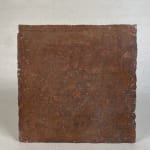








artisan's name unknown
Old Paving Tile, Circa 8th century
Clay
7 3/4" x 7 3/4" x 1 1/8"
Further images
-
(View a larger image of thumbnail 1
)

-
(View a larger image of thumbnail 2
)

-
(View a larger image of thumbnail 3
)

-
(View a larger image of thumbnail 4
)

-
(View a larger image of thumbnail 5
)

-
(View a larger image of thumbnail 6
)

-
(View a larger image of thumbnail 7
)

-
(View a larger image of thumbnail 8
)

-
(View a larger image of thumbnail 9
)

The tile was used to pave streets in its previous life. A close friend of mine - a Japanese Art dealer with an excellent eye –was traveling around Eastern Europe....
The tile was used to pave streets in its previous life. A close friend of mine - a Japanese Art dealer with an excellent eye –was traveling around Eastern Europe. He came across a construction site where they were removing tiles like these from the pavement. He approached the workers and asked what they planned to do with them. They were planning to discard them! He asked if he could have them instead, to which they responded, "yes… if you can get them out of here".
He quickly organized to have a truck pick them up and had hundreds of these tiles shipped back to Kyoto. He used them to re-tile the entire tataki (an earthen floor found in entryways of traditional Japanese houses) of his home. I had the pleasure of visiting him and see the result. It was stunning. During my visit, I noticed about ten of the tiles left piled up in the room's corner. They immediately captivated me. After some time, seeing my reaction to these tiles, he offered to let me take one home with me.
We don't know its exact date, other than from around the 8th to 10th century. However, we could say that it is an extraordinary tile from a distant past that moves us. It witnessed wars and peace and individual joy and tragedy. The simple tile changes its expression with how we look at it and how we place it. It traveled long and far from eastern Europe to Kyoto, Japan, and now here in the United States. You will join its journey. Where will you take it next?
He quickly organized to have a truck pick them up and had hundreds of these tiles shipped back to Kyoto. He used them to re-tile the entire tataki (an earthen floor found in entryways of traditional Japanese houses) of his home. I had the pleasure of visiting him and see the result. It was stunning. During my visit, I noticed about ten of the tiles left piled up in the room's corner. They immediately captivated me. After some time, seeing my reaction to these tiles, he offered to let me take one home with me.
We don't know its exact date, other than from around the 8th to 10th century. However, we could say that it is an extraordinary tile from a distant past that moves us. It witnessed wars and peace and individual joy and tragedy. The simple tile changes its expression with how we look at it and how we place it. It traveled long and far from eastern Europe to Kyoto, Japan, and now here in the United States. You will join its journey. Where will you take it next?
Signup for our Newsletter
You will receive two emails a month from us. One introduces artworks and design works from Kyoto's hidden sources and the other is stories from Misako, sharing insights into Japanese culture.
* denotes required fields
为了回应您的查询,我们将根据我们的隐私政策处理您提供的个人数据。